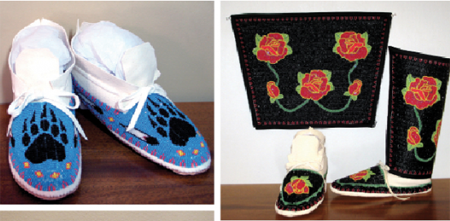
Crafted from the tanned skins of elk, deer, moose or buffalo, and in colder climates often lined with rabbit fur or sheepskin, moccasins, often accompanied by leggings, are the standard footwear for pow wows.
Since colonizing Europeans began arriving in North America and started trading their glass beads with American Indians, the art of beading on moccasins has become a tradition that has evolved into high art. Once simply adorned with shell, quill, wood and bone, the moccasins of today are intricately beaded leather canvasses that depict the wearer’s heritage and/or dance style. Beads are stitched into complex motifs to reflect tribal, clan or familial influences with fanciful botanical, geometric or animal design themes.
For Michael Knapp, of KQ Designs, based in Lexington, Kentucky, a bead artisan for the past 40 years, beadwork is like snowflakes, in that “no two designs are the same.” Knapp, of Winnebago descent, who learned the art of beading from his mother and later taught his wife how to do it, creates head-to-toe regalia. “There are several different styles for women,” he says, “depending on what is typical for their tribe or the part of the country they are from or their dance style. For men, it’s typically a basic pair of fully beaded moccasins using the lazy-stitch style of beadwork. Men who dance traditional or straight dance wear leggings. In the old days all men wore leggings. With women there are more choices.”
The pow wow dancer can choose from three basic styles, though the final product shows the limitless artistry expressed by the beader. There’s the familiar low-cut moccasin with a squared-off tongue and hole-threaded leather laces, or the high-top “desert boot” with turn-down cuffs. There’s also the mid-calf boot with thong ties that wrap around the leg and up the calf. (Floor-dusting fringe often runs along the sides or back of the boot.) Beaded leggings that cover the top of the moccasin up to the top of the calf are sometimes added to complete the outfit.

Whether pow wow dancers are performing grass dance or jingle, straight dance, fancy dance, traditional or hoop dance, beaded footwear is a considerable investment, and it must not only be beautiful but also able to withstand wear and tear. Although sinew, the animal tendon once used to lace the shoe together, is seen at art shows demonstrating traditional styles, it’s not strong enough to hold up to energetic pow wow dancing. Instead a strong thread is used, though Knapp likes to use sturdier, and pricier, waxed dental floss to ensure the beads stay on during the dancers dynamic performances.
Historically, tribes like the Kiowa and Comanche typically wore high-tops. Seminoles, who did little beadwork, used predominately patchwork appliqués with different colored materials and some accent edge beading. On the West Coast, beadwork was rare, but in the Plains, including the Dakotas, Nebraska and Iowa, there was a lot of beading, and women’s regalia had not only fully beaded yokes on their dresses, but also on their moccasins and leggings. In the Plateau region of Oregon, Washington, Idaho, western Montana and Northern Utah a different style of stitchery called flat stitch was often used—that refers to the way beads are tacked down onto deer hide or cloth. The Cheyenne were known for lazy stitch, eight to 10 beads wide.
Today much of the regalia no longer incorporates traditional stylings, and many beaders feel the change is good. “Though rhinestones and mirrors in beadwork are only from the past 15 years and don’t reflect traditional styles, it comes down to artistry and we are very open to it,” says Knapp. “It has more to do with the dancer as a beautiful piece of art.”
Juanita Growing Thunder Fogarty, Sioux/Assiniboine, is another bespoke beader whose work has won numerous awards and been featured at the National Museum of the American Indian (NMAI) in Washington, D.C. (some of her art will be presented in the upcoming NMAI exhibit Grand Procession, opening April 17) and the Denver Art Museum. While living on the Fort Peck Reservation in Montana, she learned the art from her mother, Joyce Growing Thunder, one of the most prominent beaders in North America.
As Fogarty works on a pair of smoked moose hide moccasins for her 10-year-old daughter, she explains that her family not only beads together, but dances together. “It’s a part of who we are. We were raised to dance for others,” she says. Brother George is a grass dancer and older daughter Jessa Rae Growing Thunder, Miss Indian World 2012-2013, is a competitive dancer and a beader.
Joyce and Juanita incorporate a wealth of stitches in their extraordinary designs. “Some of the stitches we use are appliqué, lazy, edging, whipstitch, Southern, peyote, brick or loom beadwork,” says Fogarty, who teaches summer classes in beading at the Idyllwild Arts center in California and refers to moccasins by the Sioux word hampas. “Mostly I use our tribal style, sticking to lazy stitch and appliqué, a two-needle stitch with one needle on top that holds the beads and another that loops over to attach it to the hide. I use materials we would have used a hundred years ago.”
There is a tremendous sense of pride at pow wows as dancers express their ancestral stories not just through the intricately stitched symbols and designs that glimmer from the light of thousands of hand-sewn glass beads and sparkling ornamentation, but by each footstep reconnecting them to Mother Earth and Father Sky. As Fogarty puts it, “The circle is a healing place. You’re there to heal others hearts and spirits.”
Read more at http://indiancountrytodaymedianetwork.com/2013/03/19/pow-wows-are-fantastic-place-see-wide-variety-moccasins-148241
